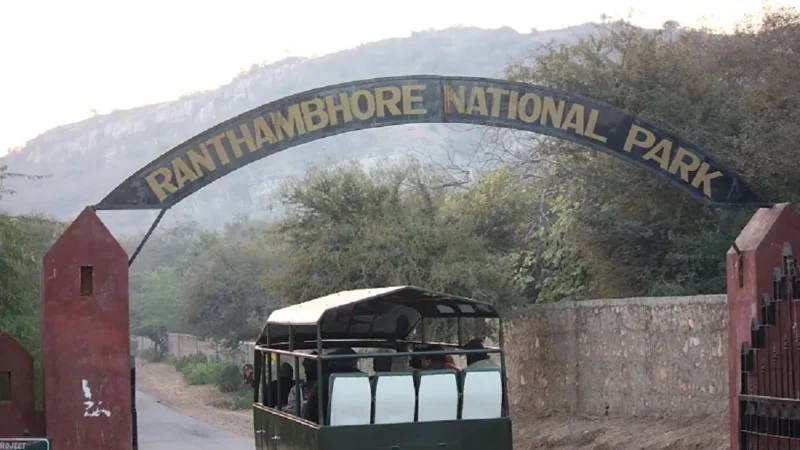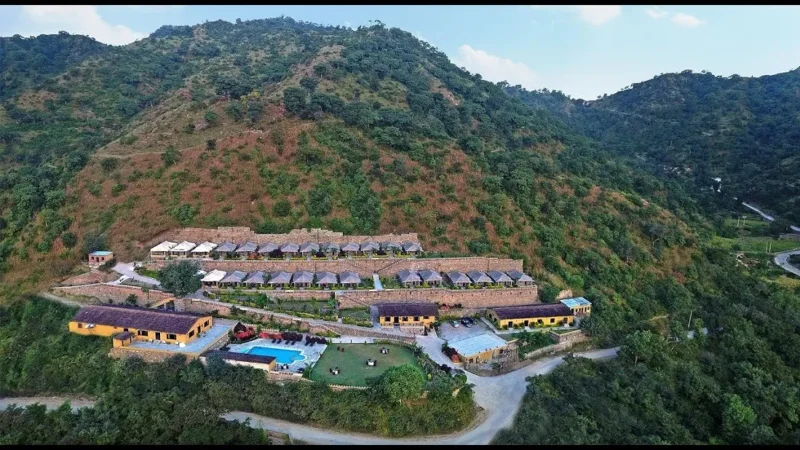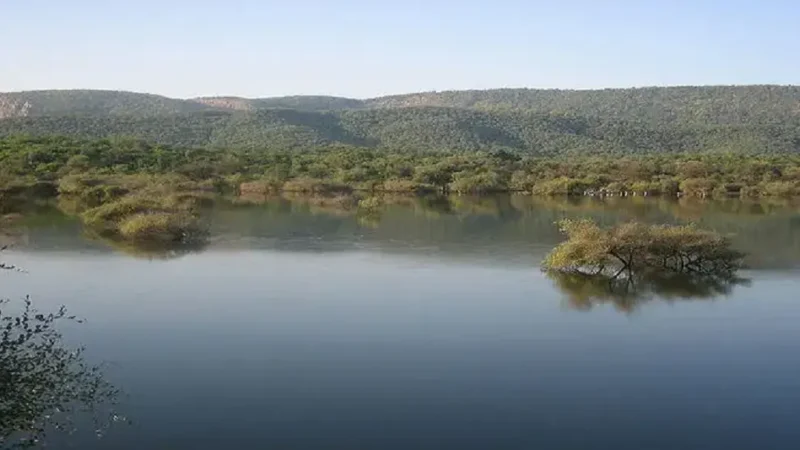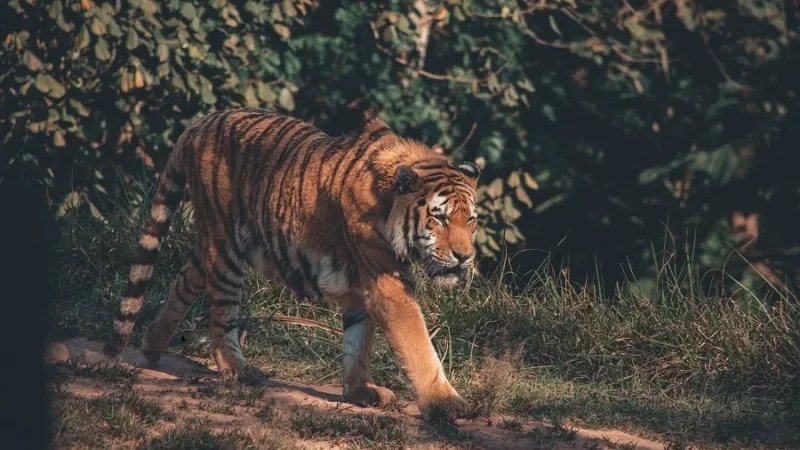Best 15 Famous Wildlife Sanctuary in Rajasthan
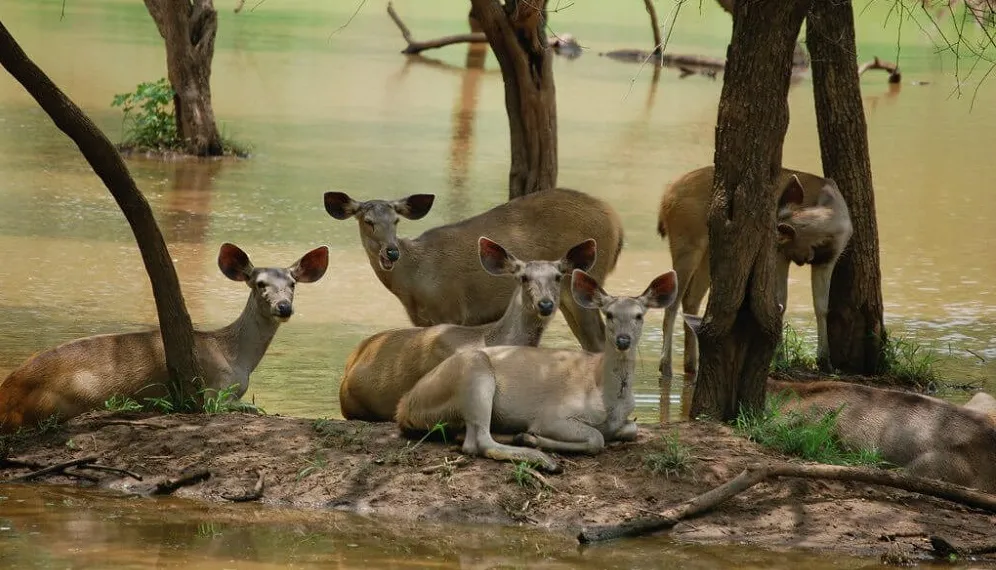
Table of Contents
ToggleRajasthan Wildlife Sanctuary -
The “Land of Kings,” Rajasthan conjures images of majestic palaces, vibrant traditions, and endless deserts. Yet, beneath this tapestry of history and culture lies a hidden world of natural wonder – the wildlife sanctuaries of Rajasthan. Nestled amidst the arid landscapes and historic forts, sanctuaries protect some of India’s most iconic and endangered species.
In this blog, we embark on an adventure into the heart of Rajasthan’s wilderness to discover its famous wildlife sanctuaries. From the regal tigers of Ranthambhore to the vibrant avian symphony of Bharatpur Bird Sanctuary, we’ll explore seventeen remarkable sanctuaries that house a breathtaking variety of flora and fauna.
Wildlife Sanctuary of Rajasthan
Here are 15 of the best and most famous wildlife sanctuaries in Rajasthan:
1- Ranthambhore National Park
Ranthambhore National Park is a national park in Rajasthan, India. It is located in the Sawai Madhopur district, about 130 kilometers (81 mi) southeast of Jaipur. The park is spread over 392 square kilometers (151 sq mi) and is home to various wildlife, including tigers, leopards, elephants, and deer.
The park is also home to some historical ruins, including the Ranthambore Fort, which the Rajputs built in the 10th century. The fort is a popular tourist destination with stunning views of the surrounding park.
Ranthambhore National Park is one of the most popular tourist destinations in Rajasthan. The park is open to visitors from 6:00 am to 6:00 pm and offers a variety of activities, including safaris, jeep safaris, and elephant safaris.
Here are some of the things you can do in Ranthambhore National Park:
- Take a safari: This is the best way to see the wildlife in the park. Safaris are available in jeeps, cars, and elephants.
- Visit the Ranthambore Fort: The fort is a UNESCO World Heritage Site and offers stunning views of the park.
- Go bird watching: The park is home to over 300 species of birds, including eagles, vultures, and falcons.
- Go hiking: There are many hiking trails in the park, ranging from easy to challenging.
- Visit the villages near the park: The villages near the park offer a glimpse of traditional Rajasthani life.
2- Sariska Tiger Reserve
Sariska Tiger Reserve is a tiger reserve in Alwar district of Rajasthan, India. It was declared a tiger reserve in 1978 and was once home to India’s largest population of tigers. However, the tigers were poached to extinction in the 1990s.
The reserve was restored and reintroduced tigers in 2005. The current population of tigers in the reserve is around 25.
The reserve is over 881 square kilometers (340 sq mi) and is home to other wildlife, including leopards, wild boars, chinkaras, and striped hyenas.
Some of the things you can do in Sariska Tiger Reserve:
- Take a safari: This is the best way to see the wildlife in the reserve. Safaris are available in jeeps and cars.
- Visit the Sariska Palace: The palace is in the heart of the reserve and offers stunning views of the surrounding forest.
- Go bird watching: The reserve is home to over 220 species of birds, including eagles, vultures, and falcons.
- Go hiking: The reserve has many trails, ranging from easy to challenging.
- Visit the villages near the reserve: The villages near the reserve offer a glimpse of traditional Rajasthani life.
The best time to visit Sariska Tiger Reserve is during the winter (November to February) when the weather is pleasant.
3- Keoladeo Ghana National Park (Bharatpur Bird Sanctuary)
Keoladeo Ghana National Park (also known as Bharatpur Bird Sanctuary) is a famous avifauna sanctuary in Bharatpur, Rajasthan, India, that hosts thousands of birds, especially during the winter season. Over 350 species of birds are known to be resident. It is also a major tourist centre, with scores of ornithologists arriving here in the hibernal season.
The park was declared a protected sanctuary in 1971 and established as a national park on 10 March 1982. Because of its exceptional avian biodiversity, 1985 Keoladeo National Park was also declared a UNESCO World Heritage Site.
The park is spread over an area of 28.73 km² (11 sq mi) and is a mosaic of dry grasslands, woodlands, woodland swamps and wetlands. These diverse habitats are home to 366 bird species, 379 floral species, 50 species of fish, 13 species of snakes, 5 species of lizards, 7 amphibian species, 7 turtle species and a variety of other invertebrates.
The park is a major bird breeding ground home to many threatened species, including the sarus crane, the greater flamingo, and the Siberian crane.
Some of the things you can do in Keoladeo Ghana National Park:
- Take a bird watching tour: This is the best way to see the variety of birds in the park. Several bird watching tours are available, ranging from half-day to full-day tours.
- Visit the Keoladeo Temple: The temple is located in the heart of the park and is dedicated to the Hindu god Brahma
- Go boating: There are many boating options available in the park, including row boats, paddle boats, and motor boats.
- Visit the Bharatpur Museum: The museum is located in the city of Bharatpur and exhibits a collection of artifacts related to the park, including bird specimens, hunting trophies, and photographs.
The best time to visit Keoladeo Ghana National Park is during the winter (November to February) when the weather is pleasant and the park is home to many migratory birds.
4- Desert National Park
The Desert National Park is in the Thar Desert in Rajasthan, India. It is located in the Jaisalmer district and is spread over 3162 square kilometres (1220 sq mi).
The park was established in 1980 and is home to various wildlife, including the desert fox, the desert cat, the sand grouse, and the Indian gazelle.
The park also has many dunes, salt lakes, and scrub forests.
Some of the things you can do in the Desert National Park:
- Take a jeep safari: This is the best way to see the wildlife in the park. The jeep safaris are conducted in the morning and evening when the temperatures are cooler.
- Go bird watching: The park is home to over 150 species of birds, including the sand grouse, the Indian bustard, and the falcon.
- Visit the Sam Sand Dunes: The Sam Sand Dunes are located in the heart of the park and are a popular tourist destination.
- Go camping: Many camping options are available in the park, including desert camping and stargazing.
The best time to visit the Desert National Park is during the winter (November to February) when the weather is pleasant.
5- Darrah National Park
Mukundara Hills National Park (earlier known as Darrah National Park) is a national park in the Jhalawar district of Rajasthan, India. Established in 2004, it is spread over 759.99 square kilometers (293.43 sq mi).
The park is home to a variety of wildlife, including tigers, leopards, sloth bears, and chinkaras.
The park is also home to many hills, rivers, and streams.
Some of the things you can do in Darrah National Park:
- Take a jeep safari: This is the best way to see the wildlife in the park. The jeep safaris are conducted in the morning and evening when the temperatures are cooler.
- Go trekking: There are a number of trekking trails in the park, ranging from easy to challenging
- Go bird watching: The park is home to over 200 species of birds, including the crested serpent eagle, the honey buzzard, and the Indian peafowl.
- Visit the Sita Mata Temple: The temple is in the heart of the park and dedicated to the Hindu goddess Sita.
The best time to visit Darrah National Park is during the winter (November to February) when the weather is pleasant.
6- Mukundra Hills (Darrah) Tiger Reserve
Mukundara Hills Tiger Reserve (MHTR), earlier known as Darrah National Park, is a tiger reserve in the Jhalawar district of Rajasthan, India. It was established in 2004 and is spread over an area of 759.99 square kilometers (293.43 sq mi).
The park is home to a variety of wildlife, including tigers, leopards, sloth bears, and chinkaras. It is also home to a number of hills, rivers, and streams.
The park is currently tigerless, as the last tiger died in 2020. However, the forest department is working to reintroduce tigers to the park.
Some of the things you can do in Mukundara Hills Tiger Reserve:
- Take a jeep safari: This is the best way to see the wildlife in the park. The jeep safaris are conducted in the morning and evening when the temperatures are cooler.
- Go trekking: There are a number of trekking trails in the park, ranging from easy to challenging.
- Go bird watching: The park is home to over 200 species of birds, including the crested serpent eagle, the honey buzzard, and the Indian peafowl.
The best time to visit Mukundara Hills Tiger Reserve is during the winter (November to February) when the weather is pleasant.
7- Kumbhalgarh Wildlife Sanctuary
Kumbhalgarh Wildlife Sanctuary is a wildlife sanctuary in the Rajsamand District of Rajasthan State in western India. It surrounds the Kumbhalgarh fortress and covers an area of 610.528 km² (236 sq mi). The sanctuary extends across the Aravalli Range, covering parts of Rajsamand, Udaipur, and Pali districts, ranging from 500 to 1,300 metres (1,600 to 4,300 ft) in elevation. It is part of the Khathiar-Gir dry deciduous forests ecoregion.
The sanctuary was established in 1971 to protect the wildlife of the Aravalli Range, including the leopard, the chinkara, the nilgai, and the wild boar. It is also home to many birds, including the crested serpent eagle, the honey buzzard, and the Indian peafowl.
The sanctuary is a popular tourist destination accessible by road from Udaipur and Rajsamand.
Some of the things you can do in Kumbhalgarh Wildlife Sanctuary:
- Take a jeep safari: This is the best way to see the wildlife in the sanctuary. The jeep safaris are conducted in the morning and evening when the temperatures are cooler.
- Go trekking: There are many trekking trails in the sanctuary, ranging from easy to challenging.
- Go bird watching: The sanctuary is home to over 200 species of birds, including the crested serpent eagle, the honey buzzard, and the Indian peafowl.
- Visit the Kumbhalgarh Fort: The fort is a UNESCO World Heritage Site and offers stunning views of the surrounding sanctuary.
The best time to visit Kumbhalgarh Wildlife Sanctuary is during the winter (November to February) when the weather is pleasant.
The cost of jungle safari in Kumbhalgarh is Rs 100 on weekdays and Rs 75 on weekends.
8- Mount Abu Wildlife Sanctuary
Mount Abu Wildlife Sanctuary is a wildlife sanctuary in the Aravalli Hills of Rajasthan, India. It is spread over 288 km² (111 sq mi) and is the only wildlife sanctuary in Rajasthan in the hills.
The sanctuary was established in 1960 to protect the wildlife of the Aravalli Hills, including the leopard, the langur, and the striped hyena. It is also home to many birds, including the crested serpent eagle, the honey buzzard, and the Indian peafowl.
The sanctuary is a popular tourist destination accessible by road from Mount Abu.
Some of the things you can do in Mount Abu Wildlife Sanctuary:
- Take a jeep safari: This is the best way to see the wildlife in the sanctuary. The jeep safaris are conducted in the morning and evening when the temperatures are cooler.
- Go trekking: There are many trekking trails in the sanctuary, ranging from easy to challenging.
- Go bird watching: The sanctuary is home to over 200 species of birds, including the crested serpent eagle, the honey buzzard, and the Indian peafowl.
- Visit the Dilwara Jain Temples: The temples are located in the heart of the sanctuary and are a UNESCO World Heritage Site.
The best time to visit Mount Abu Wildlife Sanctuary is during the winter (November to February) when the weather is pleasant.
The cost of jungle safari in Mount Abu is Rs 500 for a four-seater jeep and Rs 1000 for a six-seater jeep.
9- Tal Chhapar Wildlife Sanctuary
Tal Chhapar Wildlife Sanctuary is a wildlife sanctuary in the Shekhawati region of Rajasthan, India. It is spread over 142.50 km² (55.00 sq mi) and is home to various wildlife, including the blackbuck, the chinkara, the desert fox, and the desert cat.
The sanctuary was established in 1966 to protect the endangered blackbuck. The sanctuary is also home to many birds, including the crested serpent eagle, the honey buzzard, and the Indian peafowl.
The sanctuary is a popular tourist destination accessible by road from Bikaner, Churu, and Jhunjhunu.
Some of the things you can do in Tal Chhapar Wildlife Sanctuary:
- Take a jeep safari: This is the best way to see the wildlife in the sanctuary. The jeep safaris are conducted in the morning and evening when the temperatures are cooler.
- Go bird watching: The sanctuary is home to over 300 species of birds, including the crested serpent eagle, the honey buzzard, and the Indian peafowl.
- Visit the Karni Mata Temple: The temple is in the sanctuary’s heart and is dedicated to the Hindu goddess Karni Mata.
The best time to visit Tal Chhapar Wildlife Sanctuary is during the winter (November to February) when the weather is pleasant.
The cost of jungle safari in Tal Chhapar is Rs 100 on weekdays and Rs 75 on weekends.
10- Jaisamand Wildlife Sanctuary
Jaisamand Wildlife Sanctuary is located in the Udaipur district of Rajasthan, India. It is spread over 162 km² (62.6 sq mi) and is home to various wildlife, including deer, antelope, and wild boars.
The sanctuary is also home to many birds, including harriers, buzzards, and eagles.
The sanctuary was established in 1957 to protect the wildlife of the area. It is also a popular tourist destination accessible by road from Udaipur.
Some of the things you can do in Jaisamand Wildlife Sanctuary:
- Take a jeep safari: This is the best way to see the wildlife in the sanctuary. The jeep safaris are conducted in the morning and evening when the temperatures are cooler.
- Go trekking: There are a number of trekking trails in the sanctuary, ranging from easy to challenging.
- Go bird watching: The sanctuary is home to over 300 species of birds, including harriers, buzzards, and eagles.
- Visit the Jaisamand Lake: The lake is located in the heart of the sanctuary and is a popular spot for boating and fishing
The best time to visit Jaisamand Wildlife Sanctuary is during the winter (November to February) when the weather is pleasant.
The ticket price of Jaisamand Wildlife sanctuary is Rs. 10 for Indians and Rs. 80 for foreign residents.
11- Sita Mata Wildlife Sanctuary
Sita Mata Wildlife Sanctuary is a wildlife sanctuary situated in Pratapgarh and Chittaurgarh districts of Rajasthan, India. It is spread over an area of 422.95 square kilometers (163.41 sq mi), which is about 40% of the total land area of the district. The sanctuary is named after Sita Mata, the wife of Rama in the Hindu epic Ramayana.
The sanctuary is home to various wildlife, including leopards, chinkaras, nilgais, wild boars, jackals, foxes, and several bird species. It is also home to many endangered species, such as the blackbuck and the Indian gazelle.
Some of the things you can do in Sita Mata Wildlife Sanctuary:
- Take a jeep safari: This is the best way to see the wildlife in the sanctuary. The jeep safaris are conducted in the morning and evening when the temperatures are cooler.
- Go trekking: There are many trekking trails in the sanctuary, ranging from easy to challenging.
- Go bird watching: The sanctuary is home to over 300 species of birds, including harriers, buzzards, and eagles.
- Visit the Sita Mata Temple: The temple is in the heart of the sanctuary and dedicated to the Hindu goddess Sita Mata.
The best time to visit Sita Mata Wildlife Sanctuary is during the winter (November to February) when the weather is pleasant.
The ticket price of Sita Mata Wildlife Sanctuary is Rs. 50 for Indians and Rs. 200 for foreign residents.
12- Kailadevi Wildlife Sanctuary
Kailadevi Wildlife Sanctuary is a wildlife sanctuary in the Karauli district of Rajasthan, India. It is spread over 676.40 square kilometers (261.20 sq mi). The sanctuary is named after the Kailadevi Temple, which is located within the sanctuary.
The sanctuary is home to various wildlife, including leopards, sloth bears, nilgais, sambhars, chital, hyenas, and several bird species. It is also home to many endangered species, such as the blackbuck and the chinkara.
Some of the things you can do in Kailadevi Wildlife Sanctuary:
- Take a jeep safari: This is the best way to see the wildlife in the sanctuary. The jeep safaris are conducted in the morning and evening when the temperatures are cooler.
- Go trekking: There are many trekking trails in the sanctuary, ranging from easy to challenging.
- Go bird watching: The sanctuary is home to over 200 species of birds, including harriers, buzzards, and eagles.
- Visit the Kailadevi Temple: The temple is in the heart of the sanctuary and dedicated to the Hindu goddess Kailadevi.
The best time to visit Kailadevi Wildlife Sanctuary is during the winter (November to February) when the weather is pleasant.
The ticket price of Kailadevi Wildlife Sanctuary is Rs. 50 for Indians and Rs. 200 for foreign residents.
13- Gajner Wildlife Sanctuary
Gajner Wildlife Sanctuary is a wildlife sanctuary in the Bikaner district of Rajasthan, India. It is spread over 19.20 square kilometers (7.42 sq mi).
The sanctuary is home to various wildlife, including deer, antelope, nilgai, chinkara, blackbuck, and desert foxes. It is also home to many bird species, such as the crested serpent eagle, the honey buzzard, and the Indian peafowl.
Some of the things you can do in Gajner Wildlife Sanctuary:
- Take a jeep safari: This is the best way to see the wildlife in the sanctuary. The jeep safaris are conducted in the morning and evening when the temperatures are cooler.
- Go trekking: There are many trekking trails in the sanctuary, ranging from easy to challenging.
- Go bird watching: The sanctuary is home to over 200 species of birds, including the crested serpent eagle, the honey buzzard, and the Indian peafowl.
- Visit the Gajner Palace: The palace is located in the heart of the sanctuary and is a popular tourist destination.
The best time to visit Gajner Wildlife Sanctuary is during the winter (November to February) when the weather is pleasant.
The entry fee for Gajner Wildlife Sanctuary is Rs. 50 for Indians and Rs. 200 for foreign residents.
15- Ramgarh Vishdhari Wildlife Sanctuary
Ramgarh Vishdhari Wildlife Sanctuary is a wildlife sanctuary in the Alwar district of Rajasthan, India. It is spread over 1,080 square kilometers (417 sq mi). It is home to various wildlife, including the tiger, leopard, sloth bear, nilgai, sambar, chital, hyena, and several bird species. It is also home to many endangered species, such as the blackbuck and the chinkara.
Some of the things you can do in Ramgarh Vishdhari Wildlife Sanctuary:
- Take a jeep safari: This is the best way to see the wildlife in the sanctuary. The jeep safaris are conducted in the morning and evening when the temperatures are cooler.
- Go trekking: There are a number of trekking trails in the sanctuary, ranging from easy to challenging.
- Go bird watching: The sanctuary is home to over 200 species of birds, including the crested serpent eagle, the honey buzzard, and the Indian peafowl.
- Visit the Ramgarh Fort: The fort is located in the heart of the sanctuary and is a popular tourist destination.
The best time to visit Ramgarh Vishdhari Wildlife Sanctuary is during the winter (November to February) when the weather is pleasant.
The entry fee for Ramgarh Vishdhari Wildlife Sanctuary is Rs. 50 for Indians and Rs. 200 for foreign residents.
Final Note:
As we bid adieu to this virtual safari through Rajasthan’s wild legacy, remember that these sanctuaries are not just a part of Rajasthan’s past; they are its future. They symbolize the coexistence of culture and nature, history and conservation. They are a testament to the fact that the wild reigns supreme in this land of kings.
So, the next time you find yourself in the land of Rajasthan, venture beyond the palaces and forts, and seek solace in the sanctuary of the wild. You’ll find the heartbeat of this majestic land, where the spirit of the wild roams free, reminding us of our duty to protect and preserve the natural world for generations to come.

